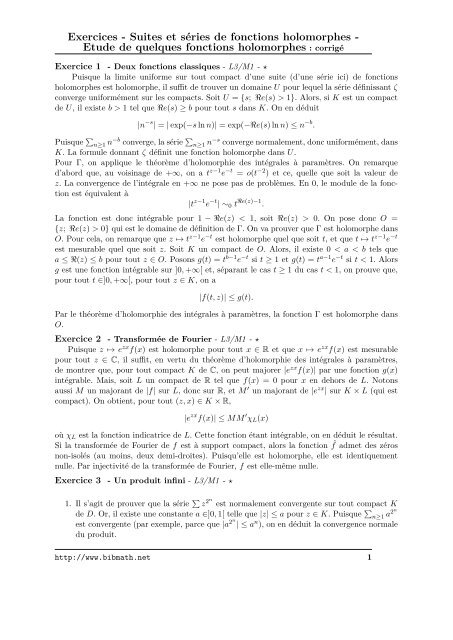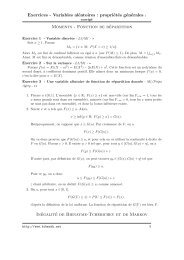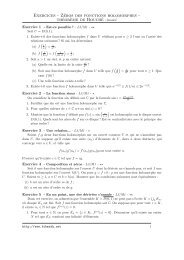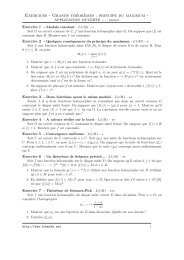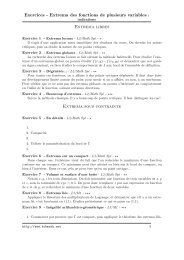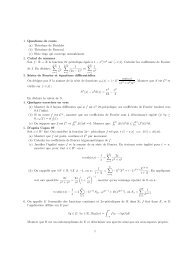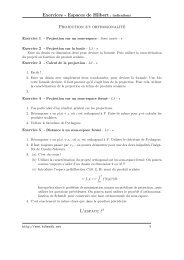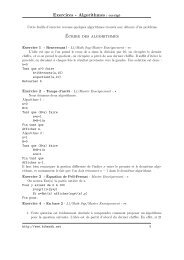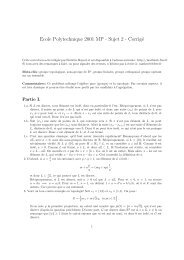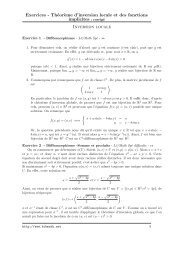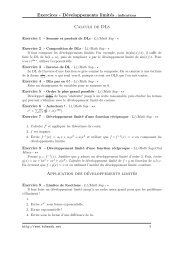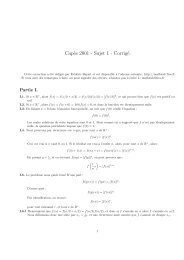Exercices - Suites et séries de fonctions holomorphes ... - Bibmath
Exercices - Suites et séries de fonctions holomorphes ... - Bibmath
Exercices - Suites et séries de fonctions holomorphes ... - Bibmath
Create successful ePaper yourself
Turn your PDF publications into a flip-book with our unique Google optimized e-Paper software.
<strong>Exercices</strong> - <strong>Suites</strong> <strong>et</strong> séries <strong>de</strong> <strong>fonctions</strong> <strong>holomorphes</strong> -Etu<strong>de</strong> <strong>de</strong> quelques <strong>fonctions</strong> <strong>holomorphes</strong> : corrigé2. C’est un calcul direct. On af(z 2 ) =+∞ ∏n=0(1 + (z 2 ) 2n) +∞ ∏=(1 + z 2n+1) = f(z)1 + z .n=03. Posons g(z) = 1/(1 − z). g vérifie la même relation que f, à savoirg(z 2 ) = 11 − z 2 = 1(1 − z)(1 + z) = g(z)1 − z .Maintenant, posons h(z) = f(z)/g(z). D’après les calculs précé<strong>de</strong>nts, pour tout z ∈ D, onah(z) = h(z 2 ) = h(z 4 ) = · · · = h(z 2n ).Par continuité <strong>de</strong> h en 0 (h est holomorphe dans D), <strong>et</strong> puisque z 2n → 0 pour z ∈ D, onen déduit que h(z) = h(0) pour tout z ∈ D. Puisque h(0) = 1, on a bien f = g.Exercice 4 - Zéros <strong>de</strong>s <strong>fonctions</strong> <strong>holomorphes</strong> bornées - M1/M2 - ⋆⋆1. En m<strong>et</strong>tant tout au même dénominateur dans le membre <strong>de</strong> gauche <strong>de</strong> l’inégalité, il suffit<strong>de</strong> prouver que|1 − ūv| 2 − |u − v| 2 = (1 − |u| 2 )(1 − |v| 2 ).La vérification est facile, il suffit <strong>de</strong> tout développer.2. On applique le résultat <strong>de</strong> la question précé<strong>de</strong>nte avec u = a n <strong>et</strong> v = z. Il vientce qui donne le résultat.1 −a n − z2 ∣1 − a n z ∣ = (1 − |a n| 2 )(1 − |z|) 2|1 − a n z| 2 > 03. En réduisant au même dénominateur, on obtient1 − b n (z) = 1 − |a (n|1 + |a )n|z1 − a n z a n<strong>et</strong> on en déduit|1 − b n (z)| ≤ 21 − |z| (1 − |a n|).Comme 1/(1 − |z|) est borné sur tout compact <strong>de</strong> D, la série ∑ (1 − b n ) est normalementconvergente sur les compacts <strong>de</strong> D. Autrement dit, le produit ∏ n b n est normalementconvergent sur les compacts <strong>de</strong> D.4. On pose f = ∏ n b n. La fonction f est holomorphe sur D, <strong>et</strong> ses zéros sont la réunion <strong>de</strong>széros <strong>de</strong>s b n . b n ne s’annulant qu’en a n , on a bien que f s’annule exactement en les a n .De plus, puisque |b n | ≤ 1 sur D, il en est <strong>de</strong> même <strong>de</strong> |f|.Exercice 5 - Convergence uniforme non triviale - L3/M1 - ⋆⋆⋆Posons f n (z) = (−1)nz−n<strong>et</strong> introduisons g n(z) = f n (z) + (−1)nn. Alorsg n (z) = (−1)n zn(z − n) .http://www.bibmath.n<strong>et</strong> 2
<strong>Exercices</strong> - <strong>Suites</strong> <strong>et</strong> séries <strong>de</strong> <strong>fonctions</strong> <strong>holomorphes</strong> -Etu<strong>de</strong> <strong>de</strong> quelques <strong>fonctions</strong> <strong>holomorphes</strong> : corrigéSoit K un compact <strong>de</strong> C <strong>et</strong> A = sup{|z|; z ∈ K}. Si n > K, alors f n <strong>et</strong> g n n’ont pas <strong>de</strong> zérosdans K. De plus, on aA|g n (z)| ≤n(n − A) .La série ∑ n g n(z) converge alors normalement sur K, donc uniformément sur K. Puisquef n (z) = g n (z) + (−1)nn<strong>et</strong> que (−1)nnne dépend pas <strong>de</strong> z, la série ∑ n f n(z) converge uniformémentsur K.Exercice 6 - Un développement en série - L3/M1 - ⋆⋆⋆1. On écritpuis on remarque queLe résultat suit immédiatement.sin(z) = sin(x + iy) = sin(x) cos(iy) + cos(x) sin(iy),cos(iy) = ch(y) <strong>et</strong> sin(iy) = ish(y).2. Soit K un compact <strong>de</strong> C. Il existe a, b ∈ R tels que a ≤ Re(z) ≤ b pour tout z ∈ K. Pourn > b, on a1|z − n| 2 ≤ 1(n − b) 2 ,<strong>et</strong> le membre <strong>de</strong> gauche est le terme général d’une série convergente. D’autre part, pourn < a, on a1|z − n| 2 ≤ 1(a − n) 2 ,<strong>et</strong> le membre <strong>de</strong> droite est le terme général d’une série convergente. Ainsi, on a une série <strong>de</strong><strong>fonctions</strong> méromorphes qui converge normalement, donc uniformément, sur les compacts,vers une fonction f qui est par conséquent elle aussi méromorphe. Les singularités <strong>de</strong> fsont en les entiers, <strong>et</strong> f est <strong>de</strong> plus 1-périodique.3. Écrivons f(z) = 1 + u(z), où u(z) = ∑ 1z 2n≥0 . La série définissant u est une série(z−n) 2<strong>de</strong> <strong>fonctions</strong> <strong>holomorphes</strong> au voisinage <strong>de</strong> 0 qui converge uniformément dans un voisinage<strong>de</strong> 0. u est donc holomorphe, <strong>et</strong> f s’écrit donc comme somme <strong>de</strong> 1/z 2 <strong>et</strong> d’une fonctionholomorphe en 0. On en déduit que la partie singulière <strong>de</strong> f en 0 est 1/z 2 .Pour g, on va effectuer un développement limité. En eff<strong>et</strong>,π 2sin 2 (πz) = 1 z 2 × 11 + O(|z| 2 ) = 1 z 2 + O(1).Ainsi, f <strong>et</strong> g ont même partie singulière en 0. Ceci signifie qu’en 0, on a f − g = O(1).Ainsi, h = f − g est une fonction holomorphe au voisinage <strong>de</strong> 0, sauf en 0, mais qui estbornée au voisinage <strong>de</strong> 0. 0 est donc une fausse singularité <strong>et</strong> h se prolonge en une fonctionholomorphe en 0. Par 1-périodicité <strong>de</strong> h, toutes les singularités <strong>de</strong> h sont effaçables, <strong>et</strong> hse prolonge en une fonction entière.4. Soit x ∈ [0, 1] <strong>et</strong> |y| > 1. On a| sin(πz)| ≥ |sh(πy)| ≥ sh(π)http://www.bibmath.n<strong>et</strong> 3
<strong>Exercices</strong> - <strong>Suites</strong> <strong>et</strong> séries <strong>de</strong> <strong>fonctions</strong> <strong>holomorphes</strong> -Etu<strong>de</strong> <strong>de</strong> quelques <strong>fonctions</strong> <strong>holomorphes</strong> : corrigécar | sin(πz)| 2 = sin 2 (πx) + sh 2 (πy). De plus,|f(z)| ≤ ∑ 11 + (x − n) 2 ≤ ∑ 11 + nn∈Zn≤02 + ∑ 11 + (n − 1)n≥12ce qui prouve que g, f <strong>et</strong> donc h sont bornés dans le domaine considéré.De plus, h est bornée, car continue, sur le compact {0 ≤ Re(z) ≤ 1, |Im(z)| ≤ 1}. Parconséquent, h est bornée sur la ban<strong>de</strong> {0 ≤ Re(z) ≤ 1}, puis par périodicité sur C toutentier. Par le théorème <strong>de</strong> Liouville, h est constante.Enfin, on va prouver que lim y→+∞ h(iy) = 0, ce qui prouvera que h = 0. En eff<strong>et</strong>, on a| sin(πiy)| ≥ |sh(πy)| → +∞ce qui prouve lim y→+∞ g(iy) = 0. Pour f, on écrit|f(iy)| ≤ ∑ n∈Z1y 2 + n 2 .Pour prouver que ceci tend vers 0 lorsque y tend vers +∞, on peut– Montrer que la série ∑ 1n∈Z converge uniformément, car normalement (on peuty 2 +n 2majorer (y 2 + n 2 ) −1 par (1 + n 2 ) −1 ) sur [1, +∞[ <strong>et</strong> utiliser le théorème d’interversion<strong>de</strong>s limites ;– Utiliser le théorème <strong>de</strong> convergence dominée pour la mesure discrète sur Z en majorant(y 2 + n 2 ) −1 par (1 + n 2 ) −1 .Dans tous les cas, on prouve que f(iy) tend vers 0 lorsque y tend vers +∞. C’est aussi lecas pour h <strong>et</strong> donc h = 0.5. Reprenons les notations <strong>de</strong>s questions précé<strong>de</strong>ntes. Puisque h(0) = 0, c’est quef(z) = 1 z 2 + a + o(1) <strong>et</strong> g(z) = 1 z 2 + a + o(1)avec la même constante a. Or, pour f, c<strong>et</strong>te constante a vaut u(0), donc 2 ∑ +∞n=1 n −2 . Pourg, il faut pousser le développement limité un cran plus loin, <strong>et</strong> on trouve π23. Ceci donnele résultat.Exercice 7 - Un pas vers Montel - L3/M1 - ⋆⋆⋆1. On utilise le théorème <strong>de</strong> Morera. Soit T un triangle tracé dans U. Puisque f n est holomorphe,on a ∫ ∂T f n(z)dz = 0. Or, on a |f n | ≤ M <strong>et</strong> une fonction constante est intégrale surle compact T . On peut passer à la limite dans l’intégrale, <strong>et</strong> on en déduit ∫ ∂Tf(z)dz = 0.La fonction f est holomorphe dans U !2. D’après la formule <strong>de</strong> Cauchy, on a, pour tout z ∈ D(z 0 , r),f n (z) − f m (z) = 1 ∫f n (w) − f m (w)dw.2iπw − zC(z 0 ,r)Puisque |w − z| ≥ r 2 pour tout w ∈ C(z 0, r) <strong>et</strong> tout z ∈ D(z 0 , r/2), on en déduit∫|f n (z) − f m (z)| ≤ M |f n (w) − f m (w)|dwoù on a posé M = (rπ) −1 .C(z 0 ,r)http://www.bibmath.n<strong>et</strong> 4
<strong>Exercices</strong> - <strong>Suites</strong> <strong>et</strong> séries <strong>de</strong> <strong>fonctions</strong> <strong>holomorphes</strong> -Etu<strong>de</strong> <strong>de</strong> quelques <strong>fonctions</strong> <strong>holomorphes</strong> : corrigé3. Il suffit d’appliquer le théorème <strong>de</strong> convergence dominée. En eff<strong>et</strong>, on a∫sup |f n (z) − f m (z)| ≤ M |f n (w) − f n (w)|dw.z∈D(z 0 ,r/2)C(z 0 ,r)De |f n (w) − f m (w)| ≤ 2C <strong>et</strong> lim n,m→+∞(fn (w) − f m (w) ) = 0, on déduit du théorème <strong>de</strong>convergence dominée queD’où le résultat.limsupn,m→+∞z∈D(z 0 ,r/2)|f n (z) − f m (z)| = 0.4. On va vérifier que la suite (f n ) satisfait le critère <strong>de</strong> Cauchy uniforme. Pour cela, onremarque que, pour tout z ∈ K, il existe un voisinage V z <strong>de</strong> K <strong>et</strong> un entier p z tel que,pour tout w ∈ V z <strong>et</strong> tout n, m ≥ p z , on asup |f n (w) − f m (w)| ≤ ε.w∈V zOr, la famille <strong>de</strong>s (V z ) z∈K forme un recouvrement ouvert du compact K. On peut enécrire un sous-recouvrement fini V z1 , . . . , V zl . Posons p = max(p z1 , . . . , p zl ). Alors, pourtout w ∈ K, w est dans un <strong>de</strong>s V zi , <strong>et</strong> par conséquent, pour n, m ≥ p ≥ p zi , on a|f n (w) − f m (w)| ≤ ε.La suite (f n ) vérifie le critère <strong>de</strong> Cauchy uniforme. Par conséquent, elle converge uniformémentsur K.Exercice 8 - Espace <strong>de</strong> Bergman - M1 - ⋆⋆⋆1. H est un sous-espace vectoriel <strong>de</strong> L 2 (Ω), <strong>et</strong> 〈˙,˙〉 est la restriction du produit scalaire <strong>de</strong>L 2 (Ω) à H.2. Soit r < d(w, ∂Ω). D’après la formule <strong>de</strong> la moyenne appliquée à f sur D(w, r) ⊂ Ω, on af(w) = 1πr∫D(a,r)2 f(z)dz.En utilisant l’inégalité <strong>de</strong> Cauchy-Schwarz, il vient|f(w)| ≤ 1( ∫ ) 1/2 ( ∫ ) 1/2πr 2 |f(z)| 2 dz1dzD(a,r)D(a,r)≤ 1( ∫ 1/2 √πrπr 2 |f(z)| dz) 2D(a,r)1≤ √ ‖f‖. πrOn obtient le résultat en faisant tendre r vers d(w, ∂Ω).3. Soit r = d(K, ∂Ω). Alors, pour tout w ∈ K, on a d(w, ∂Ω) ≥ d(K, Ω). Le résultat se déduitalors immédiatement <strong>de</strong> la question précé<strong>de</strong>nte.http://www.bibmath.n<strong>et</strong> 5
<strong>Exercices</strong> - <strong>Suites</strong> <strong>et</strong> séries <strong>de</strong> <strong>fonctions</strong> <strong>holomorphes</strong> -Etu<strong>de</strong> <strong>de</strong> quelques <strong>fonctions</strong> <strong>holomorphes</strong> : corrigé4. Soit (f n ) une suite <strong>de</strong> Cauchy <strong>de</strong> H <strong>et</strong> K un compact <strong>de</strong> Ω. De la question précé<strong>de</strong>nte,on déduit quesup |f n (w) − f m (w)| ≤ C‖f n − f m ‖w∈Koù C est une constante qui dépend <strong>de</strong> K. Autrement dit, la suite (f n ) est <strong>de</strong> Cauchypour la norme uniforme sur K. On en déduit que (f n ) converge uniformémént sur chaquecompact vers une fonction f. Par le théorème <strong>de</strong> Weierstrass sur la convergence uniforme<strong>de</strong>s <strong>fonctions</strong> <strong>holomorphes</strong>, on en déduit que f définit une fonction holomorphe sur Ω.De plus, (f n ) est une suite <strong>de</strong> Cauchy <strong>de</strong> L 2 (Ω) qui est compl<strong>et</strong>, <strong>et</strong> elle converge doncdans L 2 (Ω) vers une fonction g ∈ L 2 (Ω). Mais, sur un compact K, on a∫K|f n − f m | 2 ≤ M‖f n − f m ‖ 2 ∞où M = ∫ K 1. Faisant tendre m vers +∞, puis n vers +∞, on trouve que lim ∫n→+∞ K |f n−f| 2 = 0. Puisque lim n→+∞∫K |f n − g| 2 = 0, on en déduit que f = g presque partout, <strong>et</strong>donc que (f n ) converge vers f dans L 2 (Ω). Ainsi, f ∈ H <strong>et</strong> (f n ) converge vers f dans H :H est compl<strong>et</strong> <strong>et</strong> est donc un espace <strong>de</strong> Hilbert.http://www.bibmath.n<strong>et</strong> 6


